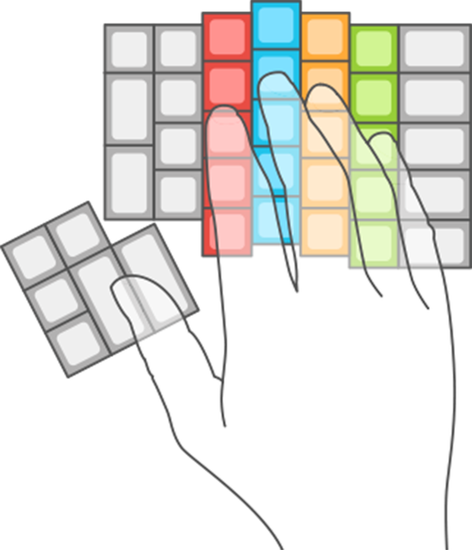
Rationale
The main goal of this kind of boards is to improve ergonomics of the keyboard and achive a healthier way to interface with the computer.
Thumb cluster
One of the first design goal of the keyboard is to make more use of the thumb, hopefully taking away some work from the pinkies. I began taking interest in this kind of design when I started my Software Engineering job as I started to type a lot and my pinkies started to hurt.
The following is the layout I normally use at work. You might notice how I moved some of the keys I usually pressed with my pinkies to the thumb cluster (ctrl, backspace, enter).

This kind of layout also removes some stress on the wirst since you don't need to move your hand as much as on a normal keyboard.
Columnar staggered layout
The keyboard is not arranged into rows like regular keyboards, it uses a columnar arrangement instead. The row staggered layout is a heritage from the old typewriters that needed such an arrangement to prevent the percussors to get stuck. Such a design is not needed anymore and doesn't fit with the human hand conformation.

Split design
The keyboard has 2 halves that you can place as far as you want, this way you can take a more comfortable posture with your wirst and shoulders.
Here's some comparison footage:


Programmable
The keyboard uses an open-source firmware called QMK (Quantum Mechanical Keyboard Firmware) this allows for a great number of features to be available for the device:
- Full programmability
- Double function keys
- Macros
- Layers
Take a look here for the complete list of features offered by QMK, these will make you fell like you have more keys than you need.
Improvements over the Ergodox design
As an Ergodox user I couldn't ignore the few flaws of the original design and in a moment of arrogance I tried to fix them, thus the Redox features:
- Easier to reach thumb cluster.
- Additional easy-to-reach rotated 1.25u thumb key.
- Reduced size.
- Reduced costs (the Redox uses Arduino Pro Micro instead of the Teensy 2.0).
- Either half can be plugged in to the PC since each half can act as the master.
- Either half can work as a standalone keyboard to be used as a macropad/gaming keyboard.
- RGB backlighting support.
- 3D-printer friendly case
- Wireless
Resources
- Project repository
- Redox handwire Thingiverse page
- Redox rev.1 Thingiverse page
- Redox rev.1 firmware sources
- Redox Wireless MCUs firmware
- Redox Wireless QMK firmware
Project details
The Redox rev.1 project consists of a PCBs designed to be used in both halves of the keyboard, a case and an open-source firmware based on the QMK firmware.
The PCB was designed using KiCad, the case was initially developed using Fusion360.
The two halves use two Arduino Pro Micros as microcontrollers connected by a TRRS cable for I2C/serial communication and power. Each half can work indipendently from the other, when used both they need to exchange data to know which key is pressed in the other half of the keyboard.
When used with a WS2812 backlight serial communication must be used since the fourth wire of the TRRS cable is used to drive the LED strip in the slave half.
Key presses are registered using the usual matrix-scanning technique.
Development
The Redox rev.1 is perfectly functional and working (I am actually typing this with it =D).
Currently I am working on a wireless version (Redox codename Ultron) since I found that the length of the cable connecting the two halves is the main source of problems:
- choosing the wrong cable length prevent the correct use of the keyboard as hands are too close to take a correct posture.
- getting a longer than needed cable makes your desk a mess of wires and knots
 Mattia Dal Ben
Mattia Dal Ben